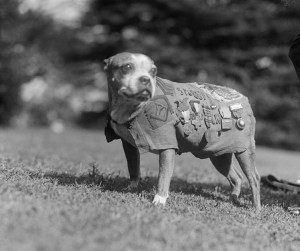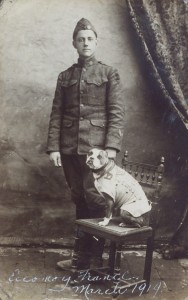Sergeant Stubby
May 3, 2018
Dogs have lived with people as pets for more than 10,000 years. Over that time, dogs have accompanied people in all sorts of situations, including when people have gone to war. Dogs fought alongside soldiers in the days of ancient Rome, and they continue to do so today. One hundred years ago, in the final year of World War I (1914-1918), one particular war dog earned military and other honors in the United States Army. That dog, a pit bull terrier named Stubby, also earned his stripes and achieved the Army rank of sergeant.

Sergeant Stubby wears his stripes and several medals on his Army uniform. Credit: Division of Armed Forces/Smithsonian National Museum of America History
Stubby was a scrawny brown-and-white puppy when he wandered onto the campus of Yale University in Connecticut in 1917. At the time, the Army’s 102nd Infantry Regiment was training there before being sent to Europe to fight in the war. Stubby seemed to enjoy running among the troops on the practice field as they marched and drilled. One of the soldiers, Private John Robert Conroy, became especially attached to Stubby.
When the 102nd received orders to board a troop ship headed for France, Conroy smuggled Stubby aboard. The rest of the men quickly became fond of the little stowaway, and Stubby became the mascot of the 102nd Regiment. The soldiers even taught the dog to salute—Stubby would raise his right front paw to his face.

John Robert Conroy and Sergeant Stubby pose for a post-war photo in March 1919. Credit: Division of Armed Forces/Smithsonian National Museum of America History
Soon after the 102nd arrived in Europe, the regiment was sent to fight on the Western Front in France. Stubby had never been trained in the horrific conditions of war, but from the beginning, the small dog reacted calmly to the noise and confusion of the battlefield. When the soldiers heard incoming shells and ran to take cover in the trenches, Stubby ran, too. Soon, with his superior canine hearing, Stubby would know that shells were coming before the men did. When the soldiers saw Stubby run for cover, they ran too.
But Stubby did more than run and hide from danger. When any of his men were injured during a battle, Stubby would run out onto the field, find the soldier, and stay with him until he could be rescued. Stubby’s daring actions resulted twice in wounds and the dog was cared for in a Red Cross hospital.
Besides his excellent hearing, Stubby also possessed a canine’s superior sense of smell. During a gas attack by the enemy, Stubby gave his troops early warning and saved the soldiers from injury or death. Stubby also carried messages across the battlefield, took turns at guard duty, and once even caught a German spy! For his service, Stubby was made an honorary sergeant in the U.S. Army.
After the war, Sergeant Stubby returned to the United States with Conroy. He was introduced to President Woodrow Wilson (whom Stubby saluted) and later met Presidents Warren G. Harding and Calvin Coolidge. Stubby marched in many parades and was named a life member of the Red Cross, the American Legion, and the YMCA.
When Conroy went to Georgetown University to study law, Stubby became the mascot of the university’s football team. Stubby often enjoyed playing with the football on the sidelines at halftime. Stubby eventually died of old age in 1926, with his favorite soldier, Conroy, at his side.
Sergeant Stubby was the subject of the 1978 children’s book, Stubby—Brave Soldier Dog. In 2018, an animated film, Sgt. Stubby: An American Hero, recounted Stubby’s story and that of his best friend, Private Conroy.


